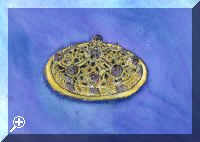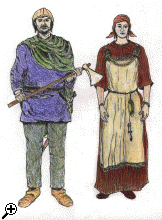866AD. Vikings Invade (Pagan Burial Site)
 The
Vikings first came to East Anglia in 866AD. The Anglo Saxon Chronicles; the
account of English history written by the monks in the reign of King
Alfred(877-899AD) recorded this event-
The
Vikings first came to East Anglia in 866AD. The Anglo Saxon Chronicles; the
account of English history written by the monks in the reign of King
Alfred(877-899AD) recorded this event-
"And the same year a great heathen army came to East Anglia; and there they were supplied with horses and the East Anglians made peace with them.
Once they had established a base in East Anglia and stocked up with horses, the Vikings made successful attacks on York. Three years later, led by Ingvar and Ubbe, they returned to East Anglia but this time met with opposition from Edmund, king of East Anglia. After a battle they killed the king and conquered all the land.
Of the first settlers themselves, the only evidence is their burial. Pagan
burials can be identified because people were buried with all their possessions
for use in the afterlife. Only the first generation of settlers were pagan- they
were converted rapidly to Christianity. Christians were not buried with their
belongings, because they believed in a spiritual, not physical, afterlife.  Probably
in the late 9th. century a Viking man and woman were buried according to pagan
custom in a double grave at Santon Downham. The burial was discovered in 1867.
Nothing survives in the grave except the metalwork, but this can give us a clue
about what the couple might have worn, and their most favoured possessions. The
woman was buried with a pair of oval brooches, the man with a sword. Oval
brooches were used to fasten the shoulder of an over dress and were a common
part of women's dress from the 9th.to the mid10th centuries. The brooch shown
here is an elaborate double-shelled one with openwork outer shell, further
decorated with silver wire.
Probably
in the late 9th. century a Viking man and woman were buried according to pagan
custom in a double grave at Santon Downham. The burial was discovered in 1867.
Nothing survives in the grave except the metalwork, but this can give us a clue
about what the couple might have worn, and their most favoured possessions. The
woman was buried with a pair of oval brooches, the man with a sword. Oval
brooches were used to fasten the shoulder of an over dress and were a common
part of women's dress from the 9th.to the mid10th centuries. The brooch shown
here is an elaborate double-shelled one with openwork outer shell, further
decorated with silver wire.